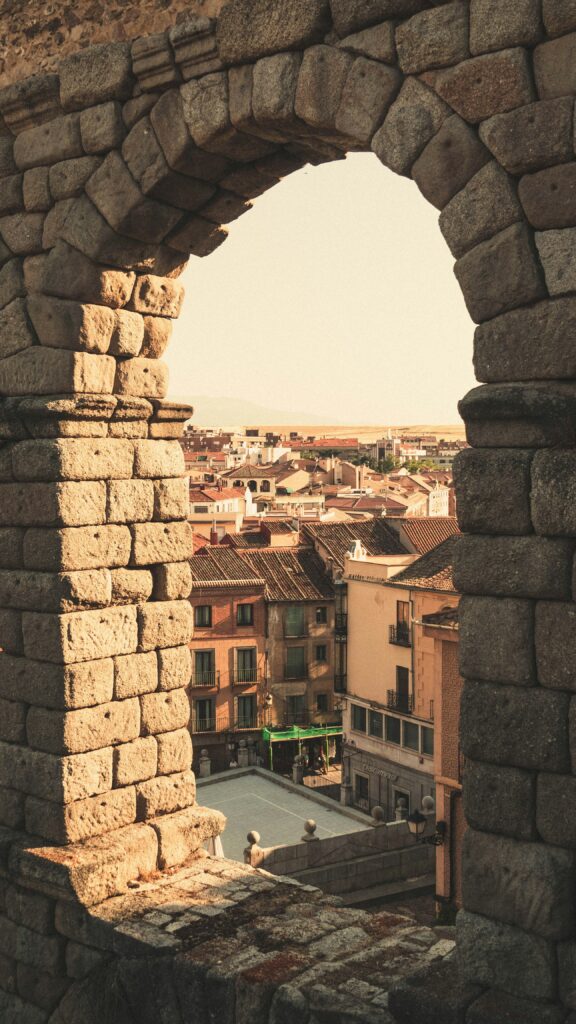Segovia Aqueduct: Exploring the Roman Engineering Marvel in Spain
Imagine Living in Segovia
Imagine living in Segovia, a beautiful city perched on a rocky hilltop. The views? Stunning. The location? Perfect for defense—you could spot invaders from miles away. Life here feels peaceful and secure, and the city’s strategic position makes it a key player in the Roman Empire. But there’s one glaring problem: no easy access to water. The nearest river is kilometers away, and hauling water up the hill every day? Not exactly convenient.
So, why stick around in such a place? Simple: Segovia was too valuable to abandon. Instead of giving up and moving to a spot with a better water source, the Romans did what they did best—they built a brilliant solution to bring water to the city.
The Regular Methods? Not Gonna Cut It Here
In most places, you’d have a few typical ways to get water. You could dig wells, but Segovia’s rocky terrain made that impossible. Maybe you could set up rainwater collection systems, but they wouldn’t be enough to sustain the city. Moving closer to the river? Not practical for a fortified hilltop settlement.
With none of these methods working, the Romans turned to their engineering prowess and decided to build an aqueduct. The construction of this aqueduct followed principles laid out by Vitruvius in his famous work, De Architectura, published in the mid-first century BC. Vitruvius, the father of architectural theory, outlined designs for durable, functional public works like aqueducts, essential to urban life.
The Smarter Choice: Granite and Arches
To tackle Segovia’s water problem, the Romans needed materials that could stand the test of time—and they found the perfect one: granite. Local granite was abundant, tough, and durable enough to handle Segovia’s extreme weather, from freezing winters to scorching summers. Not only was it practical to use, but granite’s resilience made it the ideal choice for a long-lasting structure.
And here’s where things get really impressive: the entire aqueduct was built without any mortar or glue to hold it together. Those 25,000 granite blocks were precisely cut and stacked, relying solely on gravity and their weight to stay in place.
The real magic, though, lies in the aqueduct’s 167 arches. Arches distribute weight evenly, allowing for taller, stronger structures while using fewer materials. The Segovia Aqueduct is a prime example of Roman engineers using smart techniques to solve architectural challenges. They made the most of limited resources with impressive results.
Building the Beast: The Scale of This Roman Marvel
The Segovia Aqueduct’s construction began in the late 1st century AD under Emperor Domitian and took decades to complete. The result? A structure nearly 15 kilometers long, reaching a height of 28 meters at its tallest point—about as tall as an 8-storey building or two-and-a-half times the height of the Colosseum.
Each granite block used in the aqueduct weighs around 1,800 kilograms—about the size of a small car. Quarrying and shaping these stones was no easy feat, but the real challenge was transporting and lifting them into place. Without modern machinery, the Romans relied on sheer manpower, pulleys, winches, and wooden scaffolding to hoist these heavy blocks to the top of the arches. It was a painstaking, labor-intensive process that required precision and coordination.

Myths and Legends: The Devil’s Construction Crew?
Naturally, a structure this grand came with its fair share of legends. Just like some people today jokingly suggest that aliens built the pyramids because they seem too impressive for ancient hands, the Segovia Aqueduct had its own myth. According to local lore, the aqueduct wasn’t built by Romans at all—it was the work of the devil himself. As the story goes, a young woman, tired of carrying water, struck a deal with the devil: if he could build the aqueduct in one night, he could take her soul. The devil worked tirelessly, but just as he was placing the final stone, the sun rose, and he lost the bet.
Fun as that story is, the truth is even more impressive: it wasn’t the devil’s magic but Roman engineering that built the aqueduct. Sorry, devil, but the credit for this one goes to architecture and engineering, not supernatural forces.
Why It Still Matters Today (Aside from Looking Cool on Instagram)
It’s one of the best-preserved examples of Roman engineering, earning its place as a UNESCO World Heritage site. Incredibly, the aqueduct was in active use to supply water to the city until 1973, nearly two millennia after it was first constructed. Today, the aqueduct stands as a testament to ancient craftsmanship, with modern preservation ensuring it inspires future generations.
People may marvel at its beauty on Instagram, but beyond that, the aqueduct represents the lasting impact of Roman ingenuity. With regular maintenance and monitoring, this ancient structure still stands tall. It proves that good design, whether in architecture or engineering, can outlast empires.
Conclusion: Why You Should Care About a Bunch of Stones
At first glance, the Segovia Aqueduct might just look like a well-arranged pile of stones, but it’s much more than that. It’s a testament to Roman problem-solving, ingenuity, and craftsmanship, built without modern tools, mortar, or even a named architect behind it. It was guided by timeless engineering and architectural principles set over two thousand years ago.
At the end of the day, the Segovia Aqueduct is just one of those mind-blowing ancient feats that leaves you wondering, “How did they even pull this off?” It’s survived wars, weather, and time itself, and it was still delivering water until 1973—talk about reliability! Whether you’re into Roman history, engineering marvels, or just love a good myth about devils and last-minute bets, the aqueduct is a piece of history worth appreciating. Plus, it makes for a pretty cool backdrop on your next visit to Spain!
